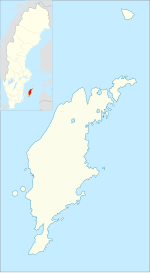Garde Church
| Garde Church | |
|---|---|
| Garde kyrka | |

Garde Church, external view
|
|
| 57°19′02″N 18°34′56″E / 57.31712°N 18.58229°ECoordinates: 57°19′02″N 18°34′56″E / 57.31712°N 18.58229°E | |
| Country | Sweden |
| Denomination | Church of Sweden |
| Administration | |
| Diocese | Visby |
Garde Church (Swedish: Garde kyrka, sometimes also Garda Church) is a medieval Lutheran church in Garde on the Swedish island of Gotland, in the Diocese of Visby.
The remains of an early stave church were discovered at the site of the presently visible church during an excavation in 1968. In the vicinity, Christian graves from the Viking Age have also been discovered, still containing the clothes of the deceased. A number of picture stones, pre-dating Christian times, have also been uncovered in the church, where they were used by the earliest builders as building material.
The first stone church was begun in the 1130s, remains of which are still preserved in the nave of the church, including a few still usable, carved stone benches, and the base of the tower. The tower was heightened during the 13th century to its present altitude. The choir is the most recent part of the church. It is from the second quarter of the 14th century and replaced an earlier, Romanesque choir with an apse. The construction of the new choir was planned as the first step in a major rebuilding scheme; however for one reason or another, the builders seem to have run out of funds and the rest of the plans were never executed - hence the somewhat unusual shape of the church. A similar fate is not uncommon for churches on Gotland, as the region suffered an economic downturn at the end of the Middle Ages.
The church retains much of the ambience of the earliest churches on Gotland: it is rather dark, the windows are small, the ceiling is flat and wooden, and the portals narrow. One of the most distinguishing features of the interior are a number of wall paintings of frescos. They depict two saints and were probably executed by a Russian artist (possibly from Staraja Ladoga) as they are Russo-Byzantine in style. The church also has a baptismal font made by the anonymous sculptor Byzantios sometime during the middle of the 12th century, and a triumphal cross made in the 13th century. The altarpiece is Baroque in style, and locally crafted.
...
Wikipedia

